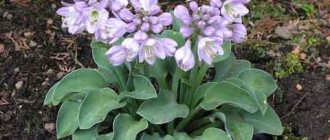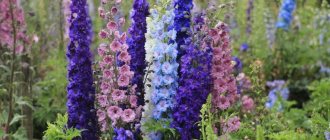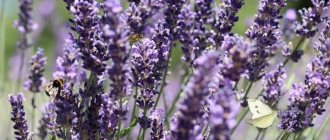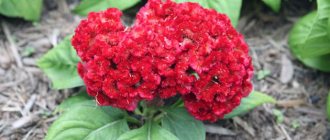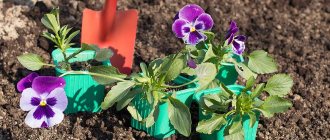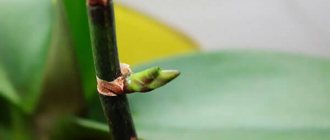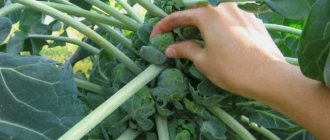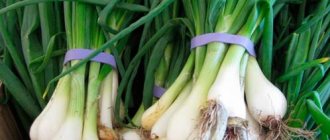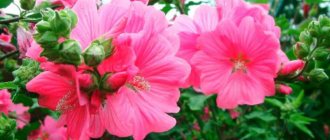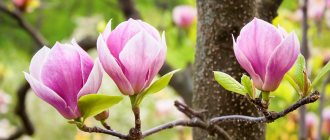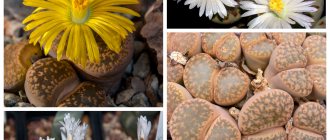Gaillardia is an annual and perennial plant from the Asteraceae family. The flower is unpretentious in care and easily tolerates drought during cultivation and winter. Because of this, it is very popular among gardeners. The plant is used to decorate flower beds and garden plots.
Dear readers! For you, we have created communities on social networks in which useful articles and interesting ideas are published several times a day! Subscribe and receive useful content in a convenient format!
Gaillardia can be grown in seedlings. This article explains how to do this.
How to determine the time of sowing gaillardia?
The timing of planting seeds depends on the growing season of the plant itself and the climate of the region. Gaillardia develops relatively quickly, so you can plant flowers for seedlings in the spring from March to early April (depending on where you live).
The specific day for sowing work is determined in accordance with the lunar calendar for the month you choose.
Reproduction
Among the methods of propagating gaillardia, only two are in greatest demand.
Dividing the bush
For this method, an adult gaillardia bush is divided into several small bushes. In this way, new plants are obtained and old ones are renewed. One bush is divided into 3-4 parts.
You can divide the bushes in the fall, then the flower will delight the gardener with its flowering in the spring. When dividing the bush in the spring, the flower may not bloom.
Important! The main rule is not to damage the roots while digging up the bush.
Gaillardia can be easily propagated by dividing the bush.
Cuttings
This method is used in the spring, in March-April. Technology:
- Cut cuttings 5-10 cm long.
- For 1 day, place them in a glass of water.
- Planted in a pot with soil or a box.
Important! When using this method, not all young cuttings take root. The method is not very reliable.
How to prepare planting material for sowing
To improve seed germination rates, the planting material that will be used for cultivation should be pre-prepared. Preparation includes disinfection and growth stimulation. But, in fact, all this can be done with one procedure, soaking.
Prepare a solution of hydrogen peroxide (a teaspoon of the drug per glass of water). Place the seeds in gauze or a regular rag. Moisten a rag with the solution and cover with the other half. Drain off excess liquid. Next, the entire structure is placed in a plastic container with a lid and placed under the table near the battery.
Every 6 hours, check the moisture content of the rag and, if necessary, wet it additionally.
After a day, remove the grains, rinse them in water and dry them.
When to plant depending on the region?
The climate of the region is the most important factor that is taken into account when sowing and growing gaillardia grains.
- In the southern regions of Russia (Crimea, Caucasus, Kuban, Astrakhan and Rostov regions), sowing can be done in the first decade of March.
- In Central Russia (Smolensk, Moscow and Tver regions, Black Earth Region), seedlings are planted in the second half of March.
- In the Volga region, the sowing time for seeds falls on the last ten days of March.
- In the North-Western regions (Pskov, Novgorod, St. Petersburg), the Urals, the Far East and Siberia, planting gaillardia should be planned for the first days of April.
Planting gaillardia seeds step by step
- Select a suitable container (plastic containers, boxes, pots, cups) and make drainage holes in the bottom.
- Place fine-grained expanded clay on the bottom for drainage.
- Fill the soil and moisten it.
- Scatter the seeds at a distance of 2-3 cm from each other.
- Press the seeds SLIGHTLY into the soil. There is no need to add grains.
- Cover with a lid or plastic bag and place under the battery.
- Regularly ventilate and moisten the plantings.
How to care for gaillardia seedlings, what are the tricks?
After the first shoots appear, the seedlings need to be provided with the necessary conditions for further growth and development.
The gaillardia seeds have sprouted, what to do next?
After 2 weeks, shoots will appear. The containers are moved to a cooler place until all the grains hatch. Usually it is 3-4 days.
Daylight hours for seedlings of these flowers should not be less than 12 hours. If necessary, use additional lighting.
Gaillardia is watered regularly, but overwatering should not be allowed. The soil must dry out, and only then can it be moistened again.
ON A NOTE. To ensure uniform development of seedlings, it is recommended to rotate the boxes from time to time.
How to feed gaillardia seedlings
To feed flowers, use Agricola, Gumi or complex fertilizer for flower seedlings. All these drugs can be bought in the store. If you prefer folk remedies, then infuse solutions from banana skins and onion peels.
Too often fertilizers are not applied. 2 feedings will be enough: the first after picking and the second after another 2 weeks.
Rules for picking gaillardia
When the seedlings have 3 true leaves, they are planted from a common box, that is, they are picked.
To do this, prepare suitable containers. For example, cups. Holes are also made in their bottoms. Then pour ¾ of the soil in there.
Now remove the seedlings from the box. First, moisten the soil so that the plants can be easily removed. Next, using an ice cream stick, carefully dig up the seedlings and, together with a lump of earth, transfer them to new containers.
IMPORTANT! The procedure must be carried out very carefully so as not to damage the root system.
Add soil to the desired level, but so as not to bury the growing point. Now very carefully water the transplanted plants and move them closer to the light.
Features of care
Planting and growing such flowers is not difficult. For such a plant, only good lighting is of greatest importance, while everything else is too important for it. The plant should be watered only during a long dry hot period. In this case, it is necessary to water moderately. But you need to remove weeds and loosen the soil regularly. The flowering of gaillardia lasts more than 8 weeks, but in order for it to last even longer, it is recommended to promptly cut off the inflorescences that have begun to fade. Tall varieties need to be tied up. Also, this flower needs to be fed 3 times per season; for this, a complete complex fertilizer is used. Fertilizing is carried out during the appearance of buds, during the flowering period, and also in autumn, about 4 weeks before the cold sets in. Remember that it is prohibited to use manure for feeding.
Transfer
We should not forget that gaillardia needs to be replanted on time, or rather, once every 5 years. During transplantation, the flower is also often propagated by dividing the rhizome.
Reproduction of gaillardia
Gaillardia can be propagated not only by seeds, but also by dividing the rhizome. After the perennial bush is 4 or 5 years old, its root system must be dug up and divided into several parts. It should be taken into account that each of the divisions must have a certain number of stems and roots. The cuttings should be planted in new permanent places. It is recommended to carry out the transplantation procedure in spring.
Root cuttings are also suitable for propagation. You should dig around the perimeter of the curtain, after which you need to find and cut off the largest roots. They are cut into five to seven centimeter lengths, which are rooted in a greenhouse.
Pests and diseases
Often aphids and whiteflies settle on the plant. To destroy them, you need to treat the bush with Actellik or Decis, but before the procedure you need to study the instructions included with the product. If you violate the rules of care, the flowers may develop gray rot, spotting, powdery mildew, and white rust. In order to get rid of such fungal diseases, the following fungicidal agents should be used: Hom, Bordeaux mixture, colloidal sulfur, Oxychom or Topaz. It is recommended to treat a bush infected with white rust with Skor.
Is it possible to immediately sow seeds in open ground?
Gaillardia can be sown directly in open ground without growing seedlings. But in this case, seed germination is noticeably lower, and seedlings develop more slowly.
Sowing in open ground is carried out when the soil has warmed up sufficiently. This usually happens 1-2 weeks before planting the seedlings. That is, approximately in May for the southern and central regions and late May - June for colder regions and republics.
The planting process itself differs little from sowing grains for seedlings:
- Dig 2-3 cm furrows at a distance of 20-30 cm from each other.
- Scatter the seeds, moisten the soil and lightly sprinkle with soil.
Now all that remains is to weed the beds and wait for the shoots.
ON A NOTE. When planting gaillardia directly in open ground, you need to be aware that the plant will bloom only next year. By the way, this is one of the reasons why the flower is grown as seedlings.
5. Diseases and pests
If there is stagnation of moisture in the soil and excessive watering, plants may suffer from horse rot. With high air humidity and insufficient air movement, the bushes can develop powdery mildew or other fungal diseases. Leaf spot. Rust. Gray rot.
Among the harmful insects, aphids can attack the flower; sometimes slugs and snails, thrips, leafhoppers, garden bugs, and whiteflies appear.
↑ Up,
When to plant seedlings in open ground?
Transplantation of seedlings into open ground occurs in May for the southern and central regions and in June for colder regions.
Gaillardia is planted for further cultivation in a sunny, well-ventilated area. However, you should not plant flowers in a draft. The soil can be pre-fertilized with a complex fertilizer containing nitrogen, phosphorus and potassium. You can also add a little sifted river sand to the soil. This will improve the structure of the soil, making it lighter and looser. The seedlings are planted 30 cm apart from each other so that they have room to grow. Don't forget to water the plantings for better rooting.
After planting, the plants can be covered with branches from trees for the first time.
ON A NOTE. When planting seedlings, focus not on the calendar, but on the weather. The temperature outside the window should be 18-20 degrees.
Types and varieties
Both annual and perennial gaillardia species are widely used in floriculture.
- Barberry: cultivation, types and varieties
Beautiful Gaillardia (Gaillardia pulchella)
Among the annual species, the beautiful gaillardia, which forms a spreading bush, is in demand in culture. Baskets with a diameter of 6-7 cm are crowned with tall thin peduncles. The color of the reed petals varies from yellow at the ends of the petals to purple-pink or purplish-red at the base. Tubular flowers of a red-brown hue. The beautiful gaillardia has several varieties:
- picta (painted) - with semi-double or double large inflorescences of various colors - bright red, two-color (red and yellow);
- Lorenza - with large double spherical inflorescences, consisting of yellow or red-yellow tubular flowers of a funnel shape with a jagged limb.
The most popular varieties:
- Red Plum - terry baskets with funnel-shaped tubular flowers of terracotta color;
- Yellow Plume - terry basket-balls of yellow tubular flowers.
In addition to those described, the varieties Lolipups and Jayeti are popular. The annual gaillardia blunt-toothed (Gaillardia amblyodon) is very rarely found in culture.
Gaillardia aristata
Of the perennial plant species, gaillardia spinosa, native to North America, is grown in culture. Its stems are straight, densely pubescent, curving at the bottom. The height of gaillardia spinosa is from 30 to 75 cm. The leaves are oblong, oval or lanceolate, pubescent, serrated or entire, the basal leaves are petiolate, the stem leaves are sessile. Single inflorescences up to 12 cm in diameter consist of variegated, bright reed flowers of predominantly copper-red, yellow and orange shades. The tubular flowers are yellow-purple. Flowering begins in June. In culture since 1812. Garden forms of this species are united under the name grandiflora gaillardia (Gaillardia grandiflora). Among the most popular varieties:
- Mandarin - a variety with red-yellow reed flowers;
- Wirral Flame - a variety with red reed flowers with a yellow border;
- Dazzer - the base of the reed flowers is dark red, the tips are yellow.
Gaillardia hybrida
Hybrid gaillardia is also grown in culture, which is the result of crossing beautiful gaillardia with other plant species. Hybrid gaillardia has shoots up to 80 cm high; its varieties bloom in June-August. The inflorescences are simple, semi-double or double, colored in red-yellow-brown tones. The most famous varieties:
- Primavera is a low-growing, compact gaillardia - the height of the bush is no more than 25 cm, but up to eight peduncles are formed from one rosette, topped with baskets with a diameter of up to 12 cm;
- gaillardia Arizona San is a dwarf variety 20 cm high, which is characterized by long and abundant flowering from early summer until frost;
- Sonne - plant height 50-60 cm, reed flowers yellow-golden, tubular flowers of a darker yellow hue.
In addition to the described perennial species, perennial lanceolate gaillardia (Gaillardia lanceolata) is sometimes grown in culture.
Interesting Facts
- Gaillardia is a close relative of the chrysanthemum, gerbera and sunflower.
- This flower tolerates drought well, which is why many gardeners love it, because it needs to be watered less often.
- Gaillardia is one of the most common plants in the central United States. Due to the color of the petals and its widespread distribution, the flower is called the “wheel of fire.”
- This flower is the official symbol of the state of Oklahoma.
Use in landscape design and combination with other colors
Evening primrose perennial (flower): planting and care
Gaillardia is used quite often in landscape design in flower beds due to the long flowering and appearance of the flowers. The bushes are compact and do not interfere with other plants nearby. Suitable for alpine slides.
They combine well with plants such as:
- cornflower;
- bell;
- marigold;
- aconites;
- delphinium;
- non-flowering herbs;
- low varieties of sunflower.
Gaillardia is most often planted together with bells, which set off the yellow flowers.
Answers to frequently asked questions
If you do not yet have sufficient experience in growing seedlings, you probably still have some questions. Let's look at the most common difficulties associated with growing gaillardia from seeds at home.
What soil should I buy for growing seedlings?
For gaillardia, universal soil, soil for flower seedlings, etc. are suitable. This crop does not have any special requirements for land. That is, the soil should be neutral, loose and light.
ON A NOTE. The structure of the soil can be improved by adding river sand in a ratio of 1 to 3.
How can you stimulate seeds for further growth?
To ensure that gaillardia grains germinate faster and suffer less pain in the future, they should be soaked in a growth stimulator before sowing. You can use both folk remedies (hydrogen peroxide solution, yeast or onion peel infusion) and chemicals (Epin, Agricola, Zircon).
Also, when the seeds are soaked, the outer shell is disinfected.
As the seedlings grow, you can feed them with the same ammonia, peroxide or store-bought products.
Why don't the seeds germinate?
There are 2 reasons why seedlings do not appear:
- Poor quality planting material.
- Errors in agricultural technology.
In order not to waste time, effort and money, purchase only “fresh” seed material, and also do not forget to carry out pre-sowing preparation of seeds.
Also make sure that the grains are not buried too deep. Very often, gardeners, out of habit, plant these flowers to a depth of several centimeters. As a result, the sprout simply does not have enough strength to break through the thickness of the earth. There is no need to cover Gaillardia with soil.
Why are seeds soaked?
There are logical reasons for soaking grains before planting:
- Seed sorting.
- Softening the outer hard shell of the grain.
- Treatment against diseases and pests.
- Stimulating growth.
It has been experimentally proven more than once that grains that have undergone the soaking procedure show better germination.
More useful information about soaking seeds can be found in our article “Soaking seeds in hydrogen peroxide before planting.”
How to harden gaillardia seedlings?
Hardening is a procedure for plant seedlings getting used to new conditions. As in the case of the human body, hardening must be carried out gradually. First, the boxes with seedlings are taken outside for 15-20 minutes. The next day for 1 hour, etc. The task is to gradually increase the presence of seedlings outside until the seedlings spend the whole day outside the house.
If the procedure did not have a negative impact, then the seedlings can be safely transplanted into the garden and flower bed.
What to do if gaillardia seedlings do not grow?
If gaillardia seedlings do not grow, it means that the rules of agricultural technology were violated, namely:
- Incorrect content temperature;
- Insufficient lighting;
- Irregular or too much watering;
- Lack of fertilizing;
- Picking of seedlings not carried out on time.
All this negatively affects plants and does not allow them to develop properly.
Gaillardia after flowering
Gaillardias bloom until frost. If you have not picked all the flowers and seed boxes have formed in their place, collect your seed material.
How and when to collect Gaillardia seeds
If you notice, the seeds of the plant resemble shuttlecocks, so when the wind blows they easily scatter throughout the area. In this way, the flower reproduces by self-sowing. To collect seeds, in the summer, select flowers after flowering and tie gauze bags to them. In the fall, around October, collect gauze bags with seeds.
You will be interested to know: Transplanting peonies to another place in the fall: how to properly transplant and care
Once again we would like to remind you that the collected seed material will not produce the same flowers as those on the mother plant. Therefore, in most cases, Gaillardia is propagated using the bush method.
